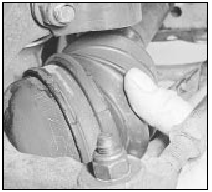Driveshaft check (Every 12 000 miles or 12 months)
1 Carry out a thorough inspection of the driveshafts and joints as follows.
2 Jack up the front of the car and support it securely on axle stands (see “Jacking and Vehicle Support”).
3 Slowly rotate the roadwheel and inspect the condition of the outer joint rubber bellows.
Check for signs of cracking, splits or deterioration of the rubber which may allow the grease to escape and lead to water and grit entry into the joint (see illustration). Also check the security and condition of the retaining clips. Repeat these checks on the inner constant velocity joints. If any damage or deterioration is found, the bellows should be renewed as described in Chapter 8.

29.3 Checking driveshaft outer joint rubber bellows
4 Continue rotating the roadwheel and check for any distortion or damage to the driveshaft.
Check for any free play in the joints by first holding the driveshaft and attempting to rotate the wheel. Repeat this check by holding the inner joint and attempting to rotate the driveshaft. Any appreciable movement indicates wear in the joints, wear in the driveshaft splines or loose retaining nut.
5 Road test the car and listen for a metallic clicking from the front as the car is driven slowly in a circle with the steering on full lock.
If a clicking noise is heard this indicates wear in the outer constant velocity joint caused by excessive clearance between the balls in the joint and the recesses in which they operate.
Remove and inspect the joint (Chapter 8).
6 If vibration, consistent with road speed, is felt through the car when accelerating, there is a possibility of wear in the inner constant velocity joint. If so, renewal of the driveshaft inner joint will be necessary.
See also:
Spark plug renewal (Every 12 000 miles (20 000 km) or 12 months)
1 The correct functioning of the spark plugs is
vital for the correct running and efficiency of
the engine. It is essential that the plugs fitted
are appropriate for the engine.
2 Make sure that t ...
Sunroof components - removal, refitting and adjustment
Sunroof panel
Removal
1 To remove this type of glass panel, pull the
sun blind into the open position and have the
sliding roof closed.
2 Wind the sliding roof handle in an anticlockwise
directi ...
Braking system warning lamps and electrical switches - removal
and refitting
General
1 All models are fitted with a low fluid level
warning switch in the master cylinder reservoir
cap and a brake pedal stop-lamp switch.
2 Some versions have front disc pad wear
sensors and ...
